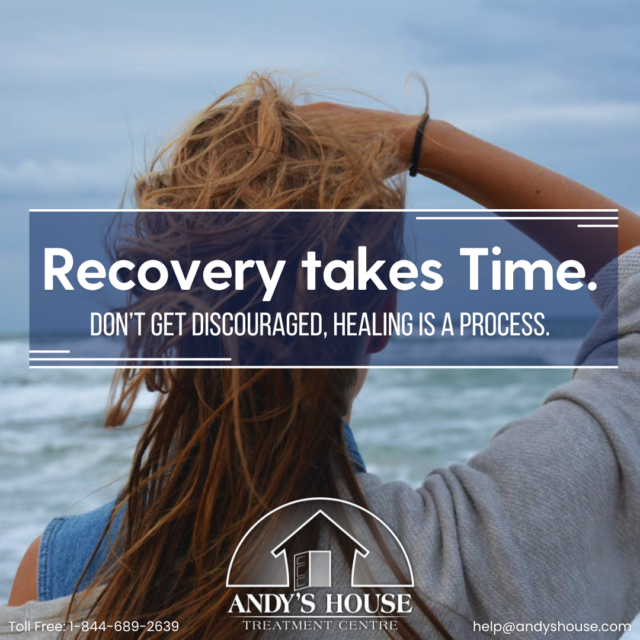Recovery Takes Time
 Healing Takes Time: A Journey Through Addiction Recovery 🌱
Healing Takes Time: A Journey Through Addiction Recovery 🌱
Recovery from addiction is a journey, not a sprint. At Andy’s House Treatment Centre, we understand that healing takes time, and we are committed to supporting individuals as they rebuild their lives. Whether you’re beginning your recovery or reinforcing your sobriety, we are here to provide guidance and care every step of the way.
Why Recovery Takes Time
Addiction changes the brain. Substance use affects areas related to reward, motivation, and memory, and recovery involves both physical and psychological healing.
-
Brain Chemistry Stabilization: During early recovery, the brain works to restore neurochemical balance. While acute withdrawal can stabilize in days to weeks, full stabilization often takes 30–90+ days, depending on the substance and severity of use (Volkow et al., 2016; Koob & Volkow, 2016).
-
Treatment Duration: Industry experts emphasize the importance of sustained treatment. Dr. Nora Volkow, Director of NIDA, notes that treatment lasting less than 90 days is generally insufficient for long-term recovery (NIDA, 2018). SAMHSA guidelines recommend residential programs of at least 90 days for best outcomes. Longer treatment supports skill development, coping strategies, and relapse prevention (SAMHSA, 2021).
At Andy’s House, we provide residential and outpatient addiction treatment for substances including alcohol, cocaine, cannabis, prescription medications, and other drugs of abuse. Our programs are evidence-based, structured, and designed to help individuals regain control of their lives safely and effectively.
The Recovery Timeline: What to Expect
Recovery is a multi-stage process. While timelines vary, individuals generally progress through the following stages:
1. Early Recovery (Detox & Initial Stabilization) – 1 to 30 Days
-
Focus: Safe detoxification, managing withdrawal symptoms, stabilizing brain chemistry.
-
Emotional State: Vulnerable, anxious, physically and emotionally challenged.
-
12-Step Introduction: Individuals may begin attending meetings (Step 1: admitting powerlessness; Step 2: seeking support from a higher power).
-
Goal: Build a foundation for sobriety and establish safety and structure.
2. Active Recovery (Therapy & Self-Reflection) – 1 to 6 Months
-
Focus: Individual and group therapy, exploring triggers, and developing coping skills.
-
12-Step Integration: Steps 3–9 focus on personal inventory, admitting wrongs, and making amends.
-
Goal: Develop healthy habits and emotional resilience.
3. Maintenance Recovery (Strengthening Sobriety) – 6 Months to 2 Years
-
Focus: Consolidating recovery skills, managing stressors, building long-term support networks.
- 2-Year Aftercare: Participants remain connected to their support network through structured weekly sessions. Aftercare provides a safe space to discuss the highs and lows of the week, receive guidance, and be held accountable for their sobriety. This ongoing connection helps reinforce healthy habits and prevent relapse.
-
12-Step Integration: Steps 10–12 involve ongoing self-assessment, spiritual growth, and helping others.
-
Goal: Strengthen relapse prevention and maintain social and emotional health.
4. Sustained Recovery (Living Beyond Addiction) – 2+ Years
-
Focus: Living a balanced, meaningful life with sobriety fully integrated.
-
12-Step Integration: Continued mentoring, sponsoring newcomers, and ongoing personal growth.
-
Goal: Achieve long-term abstinence and a fulfilling life.
Note: Timelines are approximate. Recovery is highly individual and influenced by the type of substance, duration of use, personal resilience, and treatment intensity.
Why Evidence-Based Treatment Matters
-
Residential Programs: Provide a structured, distraction-free environment for individuals with moderate to severe substance use disorders.
-
Outpatient Programs: Offer flexibility for those with mild to moderate addiction.
-
12-Step Programs: Evidence shows consistent participation improves abstinence rates and social support (Kelly et al., 2020).
-
Family Support & Aftercare: Address relational factors and provide ongoing relapse prevention.
Patience and Support: Cornerstones of Recovery
Recovery is not linear. Setbacks are common, but with structured support, individuals can overcome challenges and rebuild their lives. At Andy’s House, our staff provides compassionate guidance, individualized treatment, and ongoing aftercare to ensure success.
Start Your Journey Today
Healing takes time, but every step forward is progress. At Andy’s House Treatment Centre, we are dedicated to helping you or your loved one achieve lasting recovery. Our team provides holistic, evidence-based care in a safe, supportive environment.
Contact Us Today to learn more about our residential and outpatient programs and begin your journey toward a healthier, addiction-free life.
References
-
Volkow, N. D., Koob, G. F., & McLellan, A. T. (2016). Neurobiologic Advances from the Brain Disease Model of Addiction. NEJM, 374, 363–371.
-
NIDA. (2018). Principles of Drug Addiction Treatment: A Research-Based Guide (3rd Edition). National Institute on Drug Abuse.
-
SAMHSA. (2021). Treatment for Substance Use Disorders. U.S. Department of Health & Human Services.
-
Kelly, J. F., Humphreys, K., & Ferri, M. (2020). Alcoholics Anonymous and other 12-Step Programs for Alcohol Use Disorder. Cochrane Database of Systematic Reviews, 3(3).
-
McLellan, A. T., Lewis, D. C., O’Brien, C. P., & Kleber, H. D. (2000). Drug Dependence, a Chronic Medical Illness: Implications for Treatment, Insurance, and Outcomes Evaluation. JAMA, 284(13), 1689–1695.
